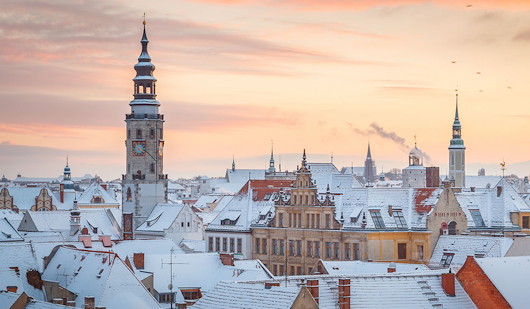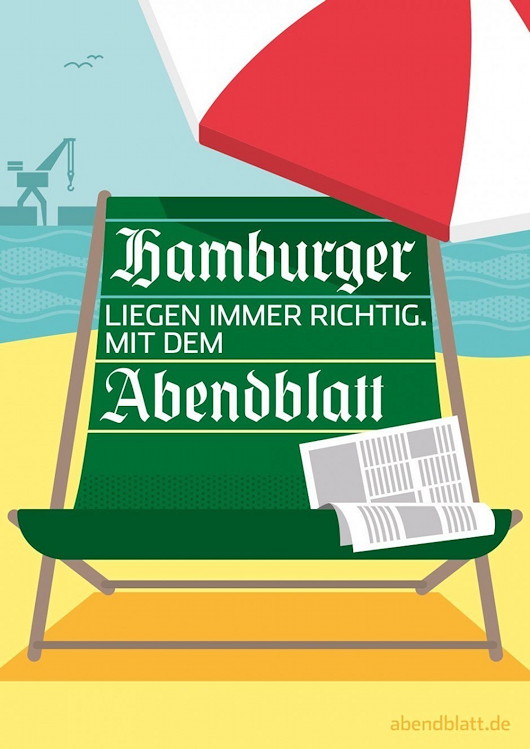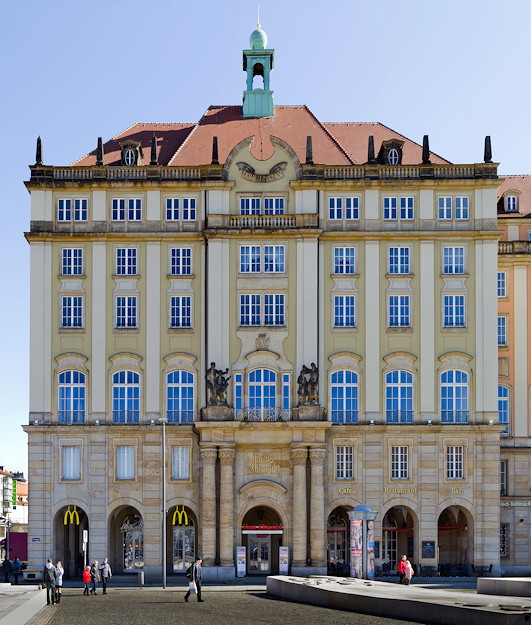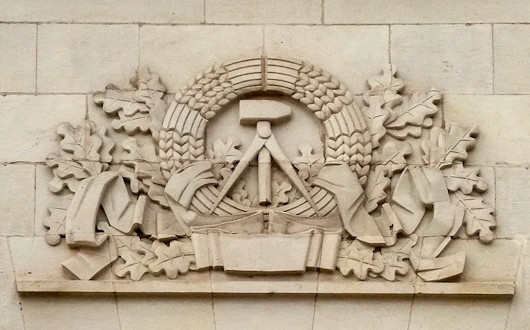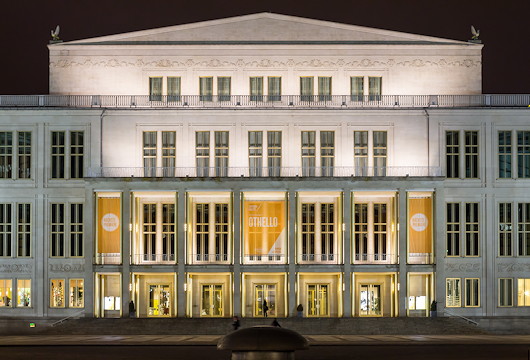Germany
About Andrew Cusack
 Writer, web designer, etc.; born in New York; educated in Argentina, Scotland, and South Africa; now based in London.
Writer, web designer, etc.; born in New York; educated in Argentina, Scotland, and South Africa; now based in London. read more
News
Blogs
Reviews & Periodicals
Arts & Design
World
France
Mitteleuropa
Knickerbockers
Argentina
The Levant
Africa
Cape of Good Hope
Netherlands
Scandinavia
Québec
India
Muscovy
Germany
Academica
Weiter vorwärts
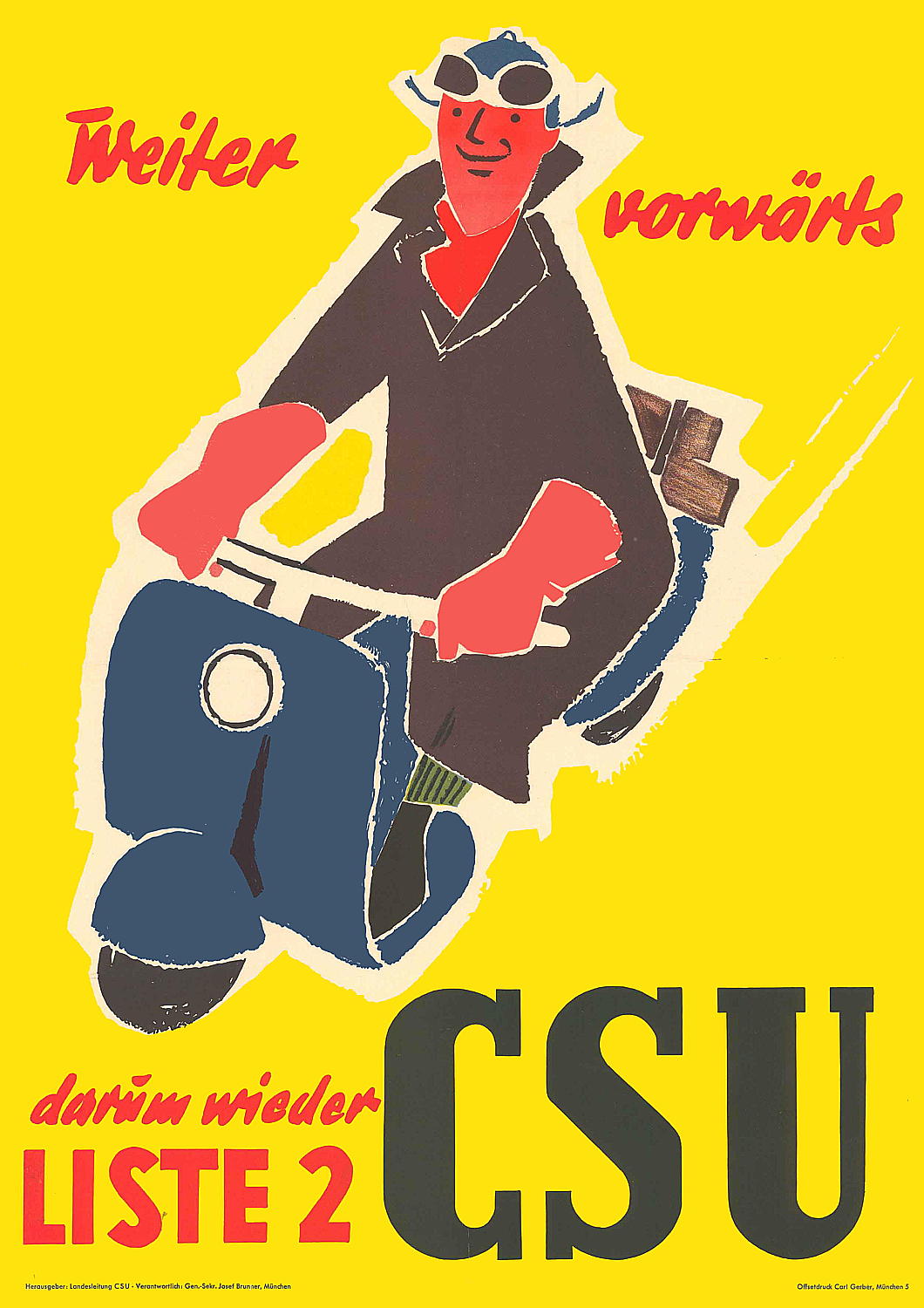
Gut Wulfshagen
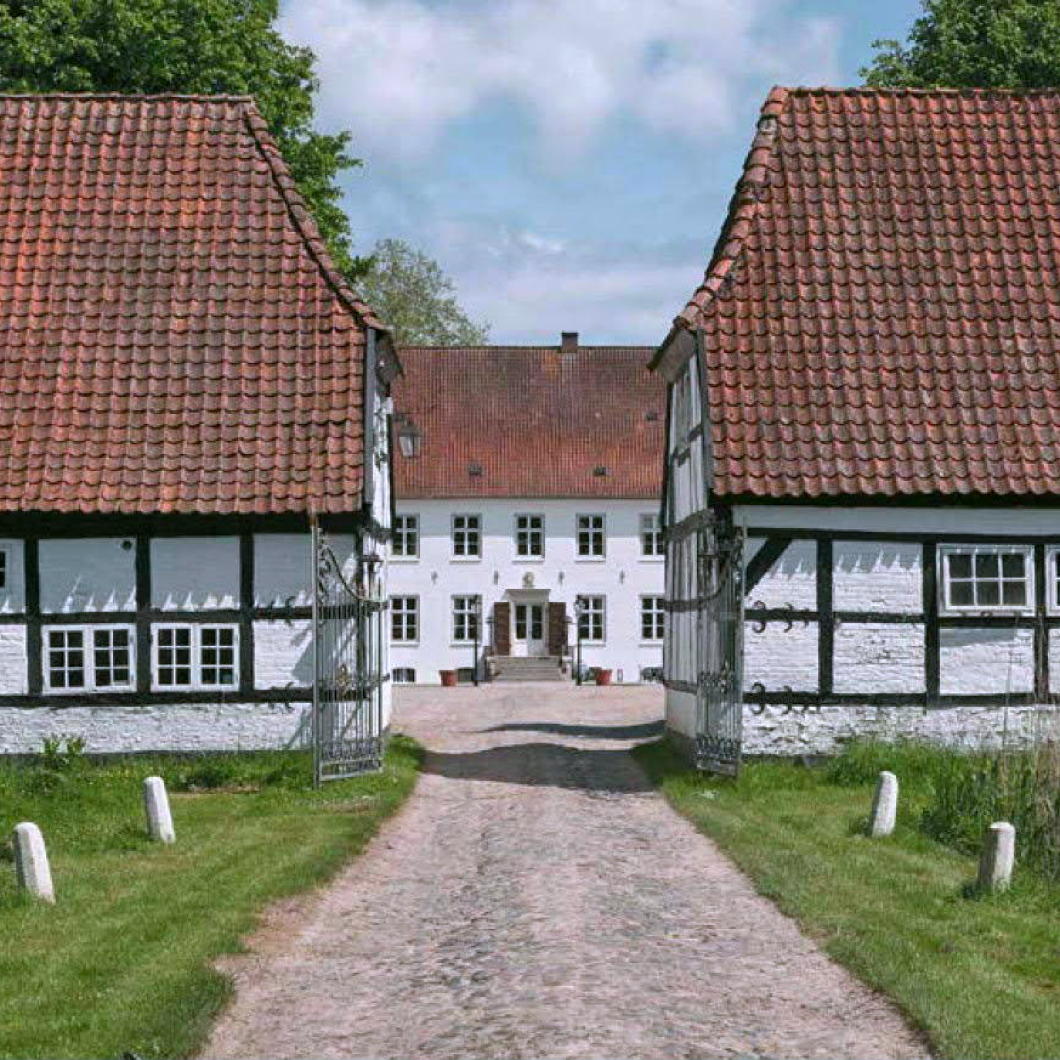
I love when a house is arranged with its farm buildings around a garth or a gaard or a hof.
At Gut Wolfshagen in Schleswig-Holstein the barns are arranged flanking a narrow pinch that gives just a hint of the manor house beyond, lending an air of baroque surprise.
This house was built by Andreas Pauli von Liliencron at the very end of the seventeenth century and was acquired by the von Qualen family in 1787.
When the last of the von Qualens here died childless in 1903 they bequeathed Gut Wulfshagen to the uxorial nephew Ludwig Graf zu Reventlow. (more…)
Articles of Note: 15.I.2021

• Autumn and winter are a time for ghouls and ghosts and eery tales. At Boodle’s for dinner two or three years ago I sat next to the wife of a friend and exchanged favourite writers. I gave her the ‘Transylvanian Tolstoy’ Miklos Banffy, in exchange for which she introduced me to the English writer M.R. James — whose work I’ve immensely enjoyed diving into. The inestimable Niall Gooch writes about Christmas, Ghosts, and M.R. James, as well as pointing to Aris Roussinos on how Britons’ love for ghostly tales is a sign of (little-c) conservatism.
• There can be few figures in English history more ridiculous than Sir Oswald Mosley. But the Conservative MP who became a Labour government minister and then British fascist führer-in-waiting was also forceful in his condemnation of the savagery unleashed by the Black-and-Tans. In 1952 a local newspaper in Ireland announced that Sir Oswald and Lady Mosley “charmed with Ireland, its people, the tempo of its life, and its scenery” had taken up residence at Clonfert Palace in Co. Galway. “Sir Oswald,” the paper noted with amazing restraint, “was the former leader of a political movement in England.” Maurice Walsh presents us with the history of Mosley in Ireland.
• The death of the late Lord Sacks, Britain’s former Chief Rabbi, was the subject of much lament. Rabbi Sacks was obviously no Catholic, but his intellect, frankness, and generosity were much appreciated by Christians. Sohrab Ahmari, one of the editors at New York’s most ancient and venerable daily newspaper, offers a Catholic tribute to Jonathan Sacks.
• “Education, Education, Education” has become a mantra in the past quarter-century and while there is a point there’s also a certain error of mistaking the means to an end for the end itself. After all, in the 1930s Germany was the most and highest educated country in the world. At Tablet, probably America’s best Jewish magazine, Ashley K. Fernandes explores why so many doctors became Nazis.
• Fifty years ago the great people of the state of New York rejected both the Republican incumbent and a Democratic challenger to elect the third-party Conservative candidate James Buckley as the Empire State’s senator in Washington. At National Review Jack Fowler tells the gleeful story of the unique circumstances that brought about this victory for Knickerbocker Toryism and how Mr Buckley went to the Senate.
Großcomburg
While the old basilica was demolished in the 1700s and replaced with a baroque creation there is still plenty of Romanesque abiding at Großcomburg in Swabia. The monastery was founded in 1078 and the original three-aisled, double-choired church was consecrated a decade later. Its community experienced many ups and downs before the Protestant Duke of Württemberg, Frederick III, decided to suppress the abbey and secularise it. Many of its treasures were melted down and its library transferred to the ducal one in Stuttgart where its mediæval manuscripts remain today.
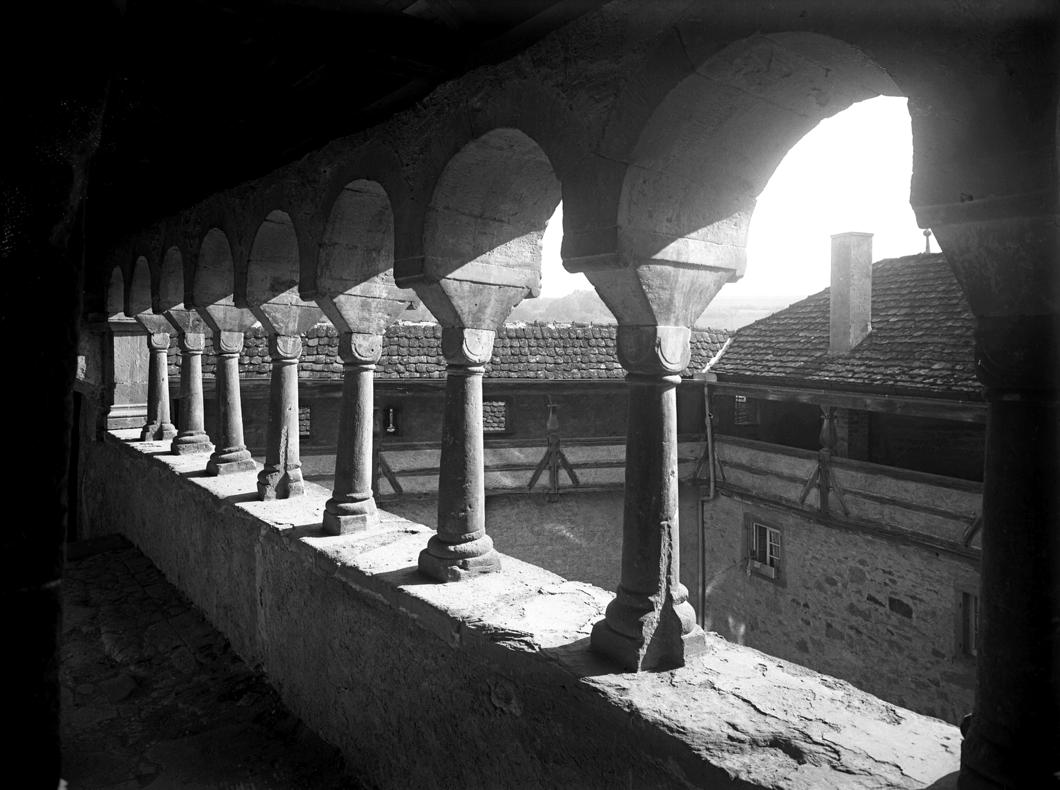
From 1817 until 1909 the abbey buildings were occupied by a corps of honourable invalids, a uniformed group of old and wounded soldiers who made their home at Comburg.
In 1926 one of the first progressive schools in Württemberg was established there, only to be closed in 1936. Under the National Socialists it went through a variety of uses: a building trades school, a Hitler Youth camp, a labour service depot, and prisoner of war camp.
With the war’s end it housed displaced persons and liberated forced-labourers until it became a state teacher training college in 1947, which it remains to this day.
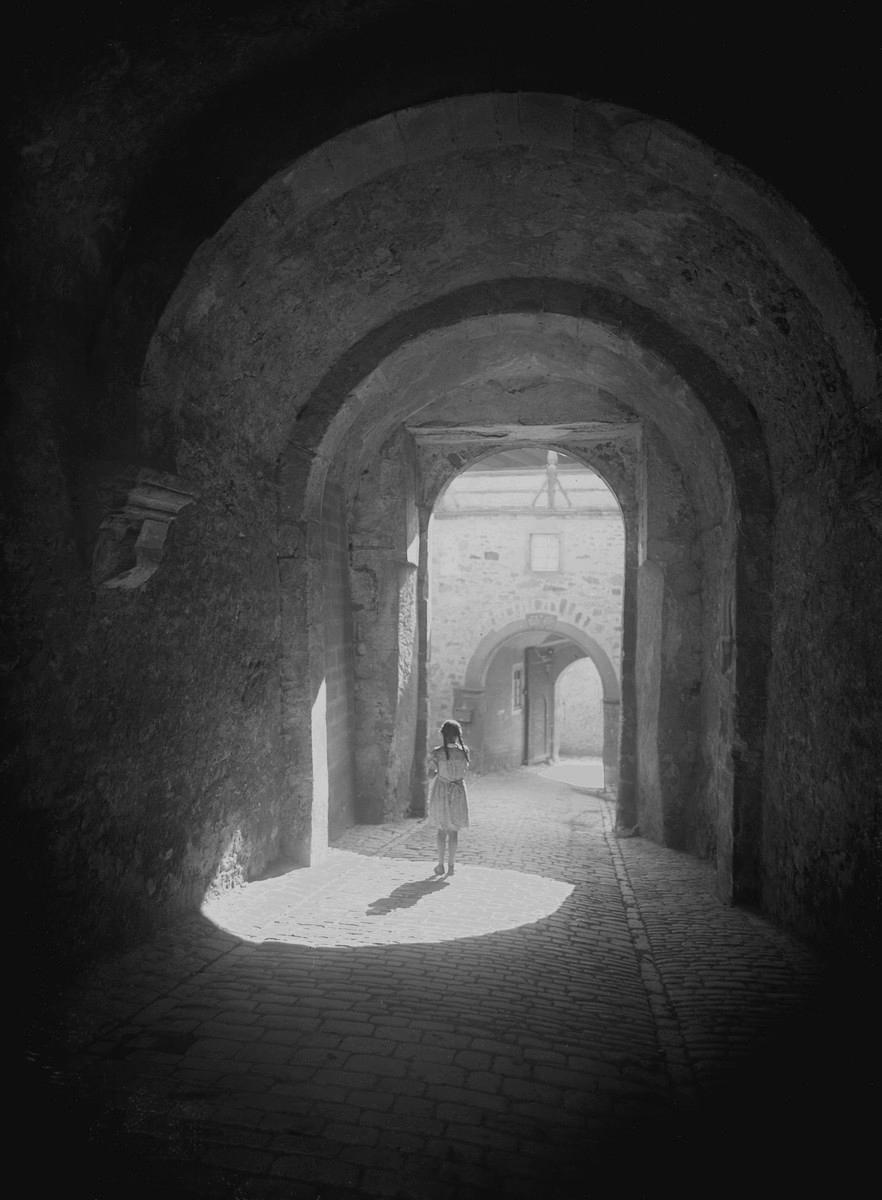
Black-and-white photography is particular suitable for capturing the beauty and the mystery of the Romanesque.
These images of Großcomburg are by Helga Schmidt-Glaßner, who was responsible for many volumes of art and architectural photography in the decades after the war.
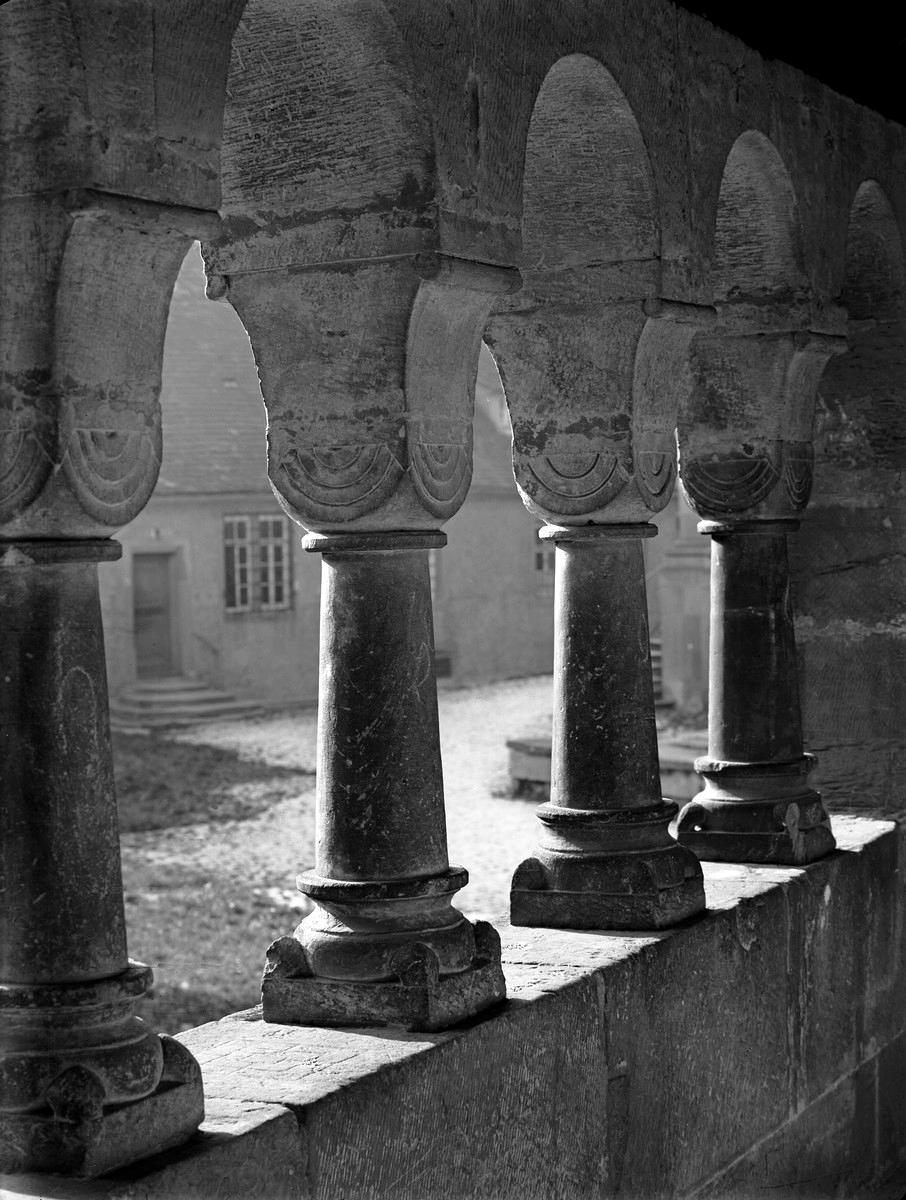
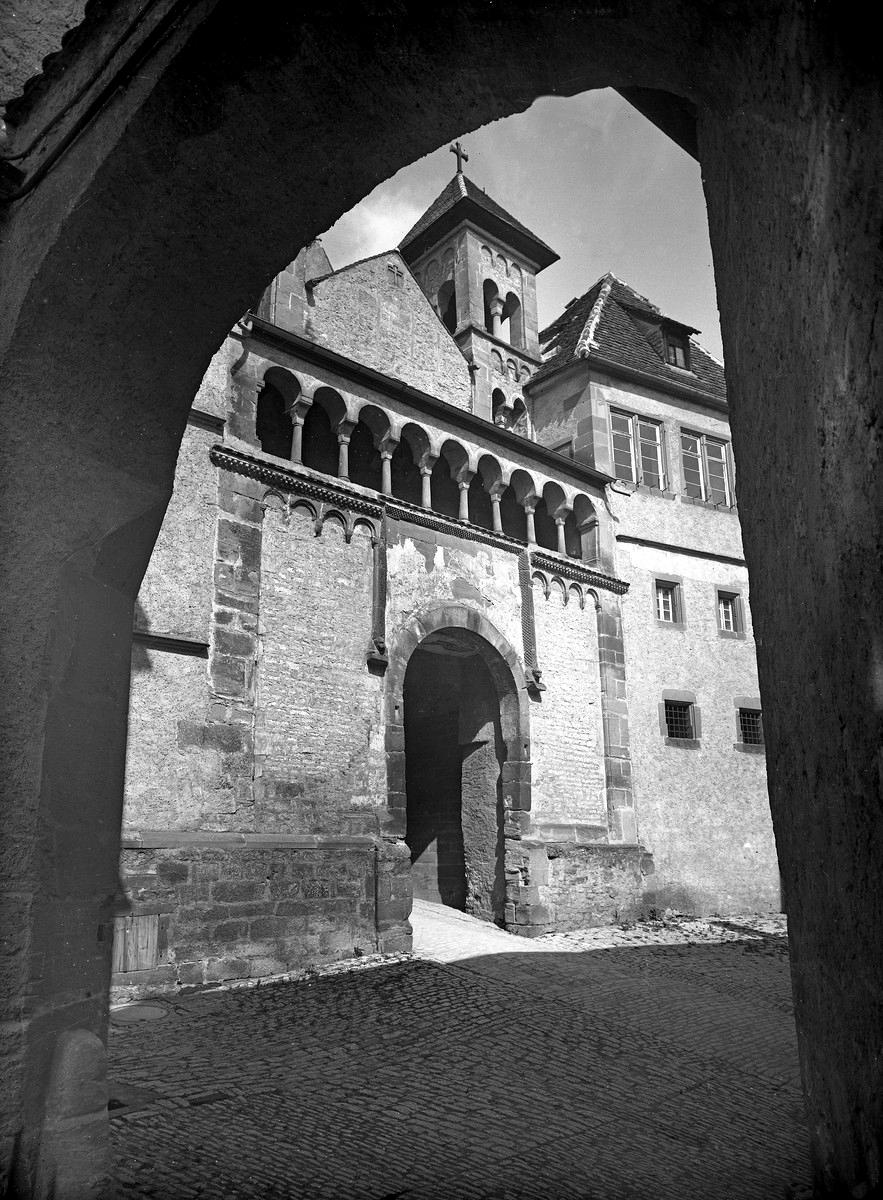
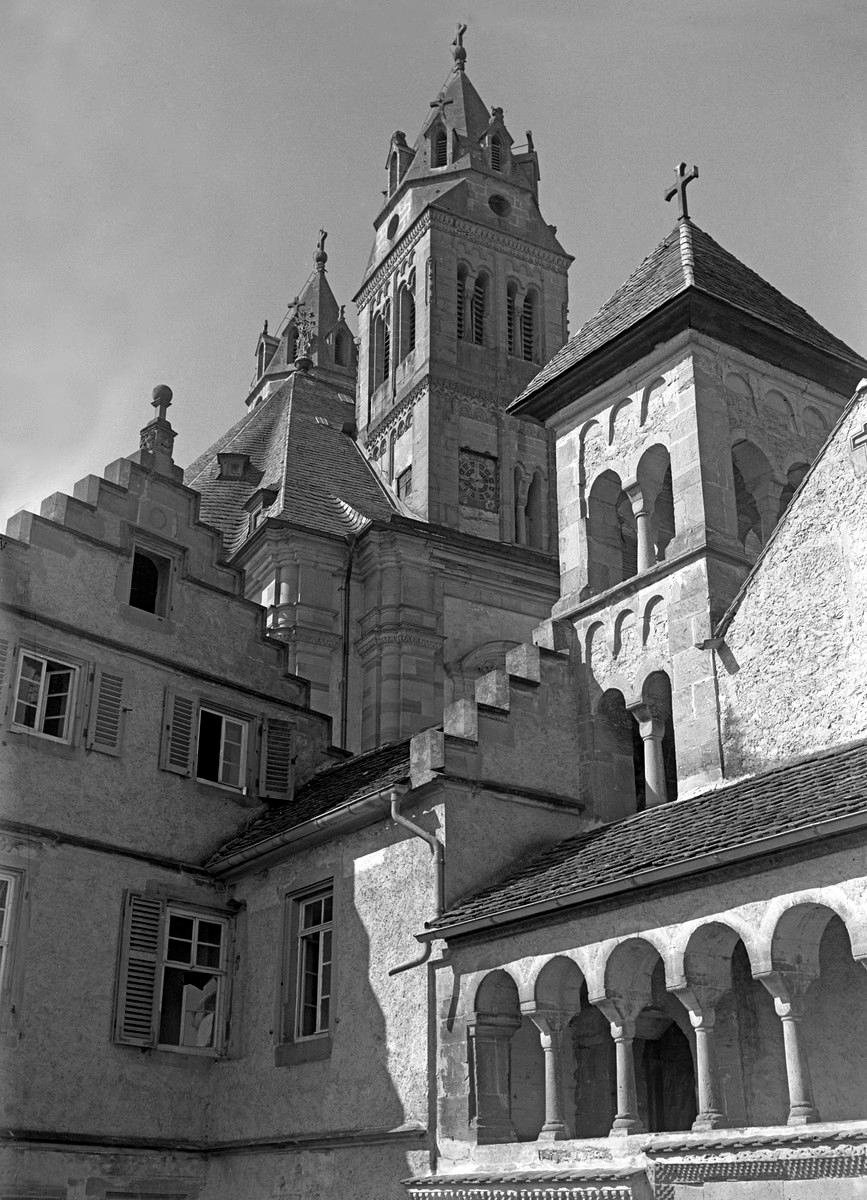
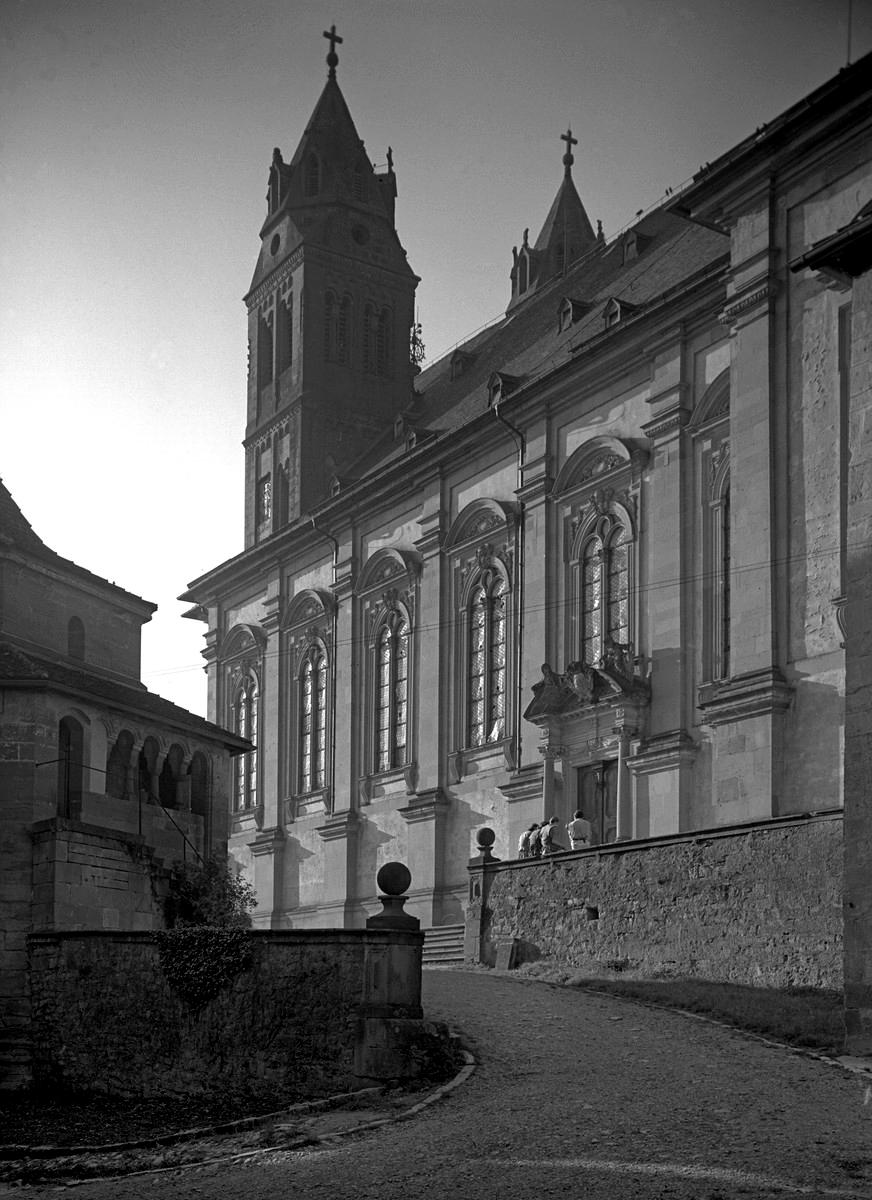
Romes that Never Were
When the splendidly named Saint Sturm – Sturmi to his friends, apparently – founded the Benedictine monastery of Fulda in A.D. 742 we can presume he had no idea that the magnificent church eventually erected there (above) would one day be considered for housing the Supreme Pontiff of the Universal Church.
Rome, caput mundi, is ubiquitously acknowledged by all Christian folk as the divinely ordained location for the Papacy, but this has not always been acknowledged in practice. Most memorable is the “Babylonian Captivity” of the fourteenth century when the papal court was based at the enclave of Avignon surrounded by the Kingdom of Arles. The illustrious St Catherine of Siena was influential in bringing that to an end.
Since the return from Avignon the Successor of Peter has prudently been keen to stay in Rome, but various crises over the past two centuries have seen His Holiness shifted about. General Buonaparte successively imprisoned Pius VI and Pius VII while he made to refashion Europe in his likeness, and the later slow-boil conquest of the Italian peninsula by the Kingdom of Sardinia caused much worrying in the courts of the continents as well.
In 1870, the Eternal City fell to the troops of General Cadorna, and while the Vatican itself was not violated it was widely assumed the papacy could not stay in Rome. Pope Pius IX evaluated several options, one of them seeking refuge from – of all people – the Prussian king and soon-to-be German emperor Wilhelm I.
Bismarck, no ally of the Church, but shrewd as ever, was in favour of it:
I have no objection to it — Cologne or Fulda. It would be passing strange, but after all not so inexplicable, and it would be very useful to us to be recognised by Catholics as what we really are, that is to say, the sole power now existing that is capable of protecting the head of their Church. …
But the King [Wilhelm I] will not consent. He is terribly afraid. He thinks all Prussia would be perverted and he himself would be obliged to become a Catholic. I told him, however, that if the Pope begged for asylum he could not refuse it. He would have to grant it as ruler of ten million Catholic subjects who would desire to see the head of their Church protected. …
Rumours have already been circulated on various occasions to the effect that the Pope intends to leave Rome. According to the latest of these the Council, which was adjourned in the summer, will be reopened at another place, some persons mentioning Malta and others Trent.
Bismarck mused to Moritz Busch what a comedy it would be to see the Pope and Cardinals migrate to Fulda, but also reported the King did not share his sense of humour on the subject. The advantages to Prussia were plain: the ultramontanes within their territories and throughout the German states would be tamed and their own (Catholic) Centre party would have to come on to the government’s side.
In the end, of course, the Pope decided to stay put in Rome and became the “Prisoner of the Vatican”, surrounded by an awkward usurper state that made attempts at friendship without betraying its hopes for legitimising its theft of the Papal States. It was the diplomatic coup of the Lateran Treaty in 1929 that finally allowed both states to breathe easy and created the State of the City of the Vatican, an entity distinct from but subservient to the Holy See of Rome.
The Second World War brought its own threats to the Pope’s sovereignty, and the wise and cautious Pius XII feared he might be imprisoned by Hitler just as his predecessor and namesake had been by Buonaparte. Pius was determined the Germans would not get their hands on the Pope and so signed an instrument of abdication effective the moment the Germans took him captive. He would have burnt his white clothing to emphasise that he was no longer the Bishop of Rome.
The record is not yet firmly established but it is rumoured that the College of Cardinals was to be convened in neutral Éire to elect a successor. One wonders where they would have met. The Irish government would undoubtedly have put something at their disposal — Dublin Castle perhaps? Despite the whirlwind of war, the election of a pope in St Patrick’s Hall would have warmed the cockles of many Irish hearts.
But what then? Ireland’s neutrality would have been useful but a German violation of the Vatican’s territory would have been grounds for open, though obviously not military, conflict. Further rumours, also totally unsubstantiated, had it that the King of Canada, George VI, quietly had plans drawn up for offering the Citadelle of Quebec to the Pope to function as a Vatican-in-Exile. Others claim it wasn’t until the 1950s that Quebec was investigated as a possibility by the Vatican in case Italy went communist, as was conceivable.
So Cologne, Fulda, Malta, Trent? None of these plans ever occurred, thank God.
And what about England? Why not? The court of St James and the Holy See, despite obvious and significant differences, enjoyed close relations and overlapping interests in many particular circumstances from the Napoleonic wars until present. Pius IX had put feelers out to Queen Victoria’s minister in Rome, Lord Odo Russell, in 1870 but the British ambassador more or less told him of course the Pope would be welcomed in England but don’t be silly, the Sardinians would never conquer Rome.
One imagines the British sovereign would grant a palace of sufficient grandeur to the exiled Pontiff. Hampton Court would do the job. It’s far enough from the centre of London but large enough to house a small court and the emergency-time administration of the Holy Roman Church. Would the ghost of Cardinal Wolsey plague the Princes of the Church?
Thanks be to God, we’ve never had cause to find out. At Rome sits the See Peter founded and so it looks to remain. Ubi Petrus, ibi ecclesia.
CDU @ 75
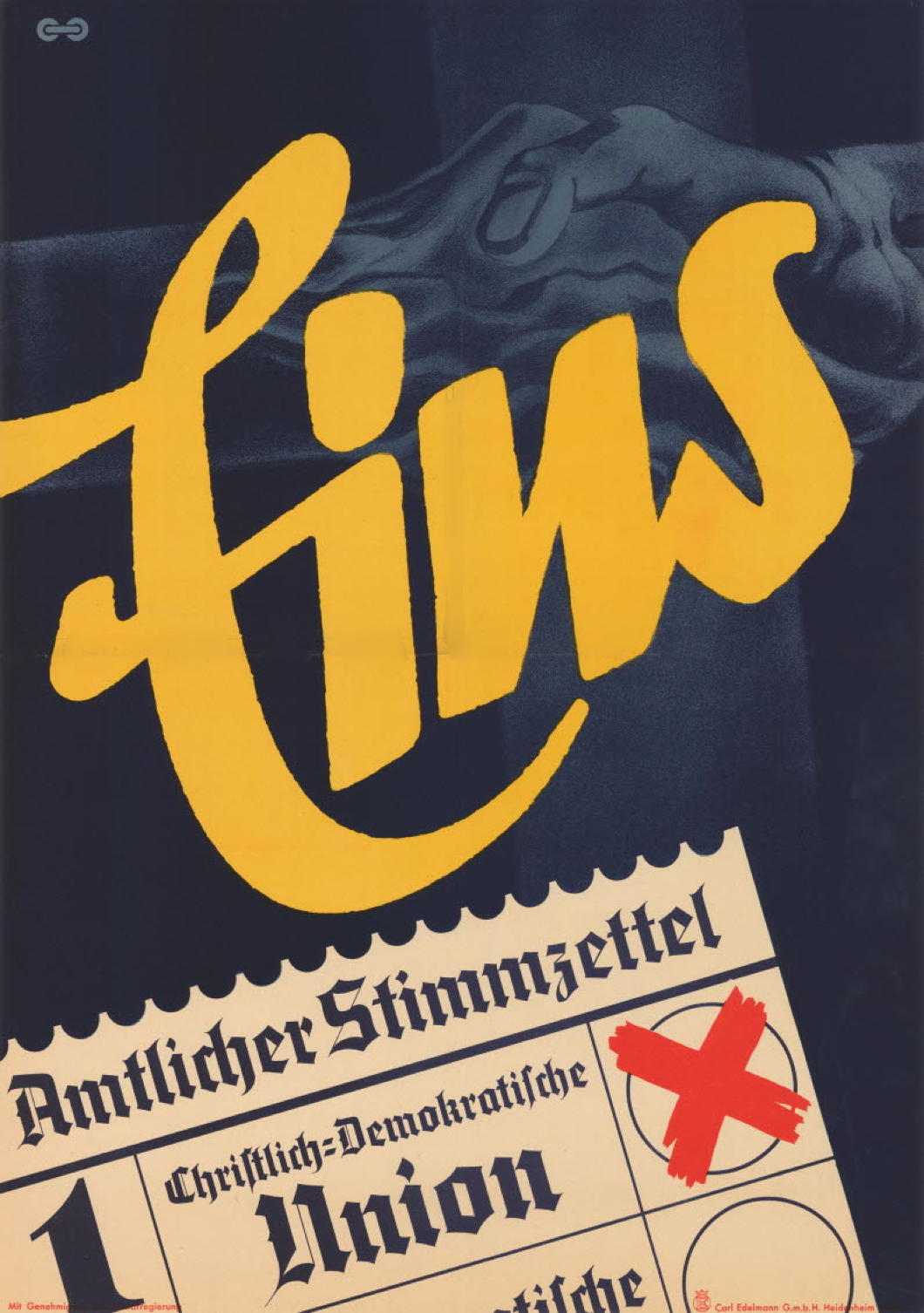
Last week was the seventy-fifth anniversary of the foundation of Germany’s Christian Democratic Union, one of the most successful democratic political parties in postwar Europe.
Indeed, under Adenauer the CDU was one of the institutions which transformed relations between the peoples of Europe and started the process of integration which, alas, has not aged well.
Nonetheless, here are some election posters from the early years of the CDU — plus one from the 1980s. (more…)
Hammerstein’s Four Types
Speaking to a friend the other day, I mentioned this quotation which is often incorrectly attributed to Rommel (including by me).
The actual source of these words is Kurt von Hammerstein-Equord, a four-star general of the German army, who described the four types of officer and their place along the axes of being 1) either clever or stupid, and 2) either hardworking or lazy.
There are clever, hardworking, stupid, and lazy officers. Usually two characteristics are combined.
Some are clever and hardworking; their place is the General Staff.
The next ones are stupid and lazy; they make up ninety percent of every army and are suited to routine duties.
Anyone who is both clever and lazy is qualified for the highest leadership duties, because he possesses the mental clarity and strength of nerve necessary for difficult decisions.
One must beware of anyone who is both stupid and hardworking; he must not be entrusted with any responsibility because he will always only cause damage.”
I am sure the experience of many would confirm that Hammerstein’s typology is also applicable in the civilian world.
Hammerstein was a brave man, who unsuccessfully attempted to see President Hindenburg personally in the hopes he would intervene to stop the massacre on the Night of Long Knives.
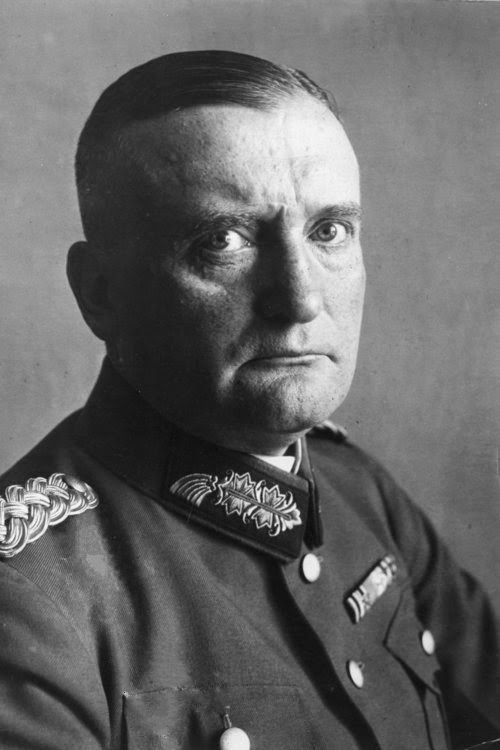 His friend and regimental comrade General Kurt von Schleicher, the last Chancellor of Germany before Hitler’s appointment, was among those murdered on the evening and Hammerstein defied army orders by attempting to attend Schleicher’s funeral only to be stopped by the SS.
His friend and regimental comrade General Kurt von Schleicher, the last Chancellor of Germany before Hitler’s appointment, was among those murdered on the evening and Hammerstein defied army orders by attempting to attend Schleicher’s funeral only to be stopped by the SS.
Nonetheless, his reputation and skill ensured he was given command during the war, although Hitler later personally dismissed him for his opposition to national socialism.
As Hammerstein was dying of cancer in 1943 he told the art historian Udo von Alvensleben-Wittenmoor: “I am ashamed to have belonged to an army that witnessed and tolerated so many crimes”.
His family refused to allow Hammerstein to be buried with a military funeral as it would have meant his remains being draped in the swastika flag.
Despite being a conservative Protestant nobleman of the old school, two of his five children ended up as communists, though his youngest son became a Protestant theologian.
The greatest church architect you’ve never heard of
The greatest church architect
you’ve never heard of
Ludwig Becker and His Churches
For such a prolific church architect of such high quality, not much is known about Ludwig Becker and, alas, he seems to be little studied. Born the son of the master craftsman and inspector of Cologne Cathedral, Becker had church building in his blood. He studied at the Technische Hochschule in Aachen from 1873 and trained as a stone mason as well.
In 1884 Becker moved to Mainz where he became a church architect and in 1909 he was appointed the head of works at Mainz Cathedral, a position he held until his death in 1940. His son Hugo followed him into the profession of church architecture.
That’s about all I can find out about Becker. But here are a selection of some of his churches, to get a sense of his agility in a wide variety of styles.
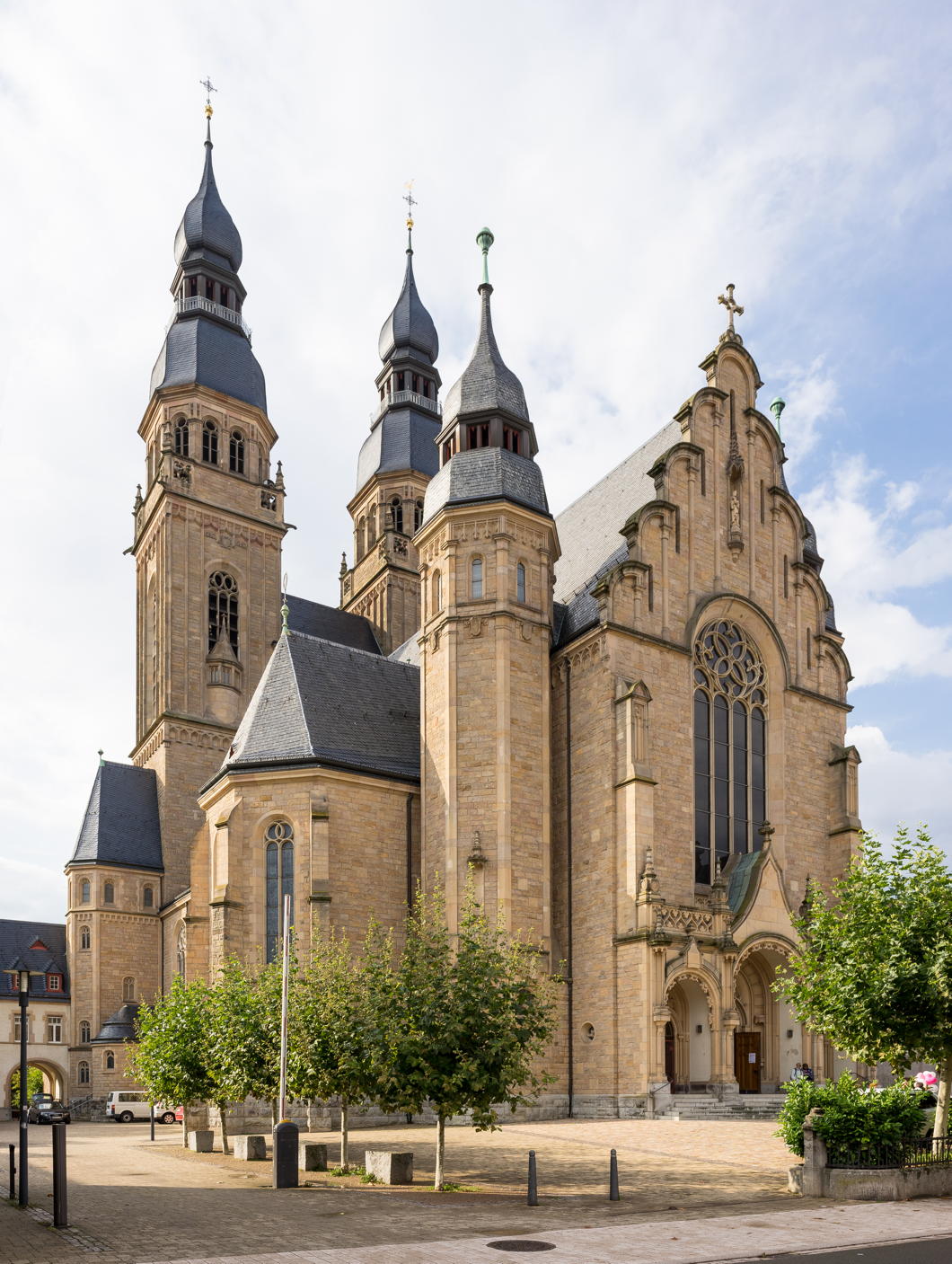
St Joseph, Speyer, is my favourite of Becker’s churches for the beautiful organic fluidity of its style. Here Art Nouveau, Gothic, and Baroque are mixed somehow without affectation. Rather enjoyably, it was built as a riposte to a nearby monumental Protestant church commemorating the Protestant Revolt. These two rival churches are the largest in the city after its famous cathedral. (more…)
‘Solving’ Middle Europe
Ralph Adams Cram’s First-World-War Plan for Redrawing Borders
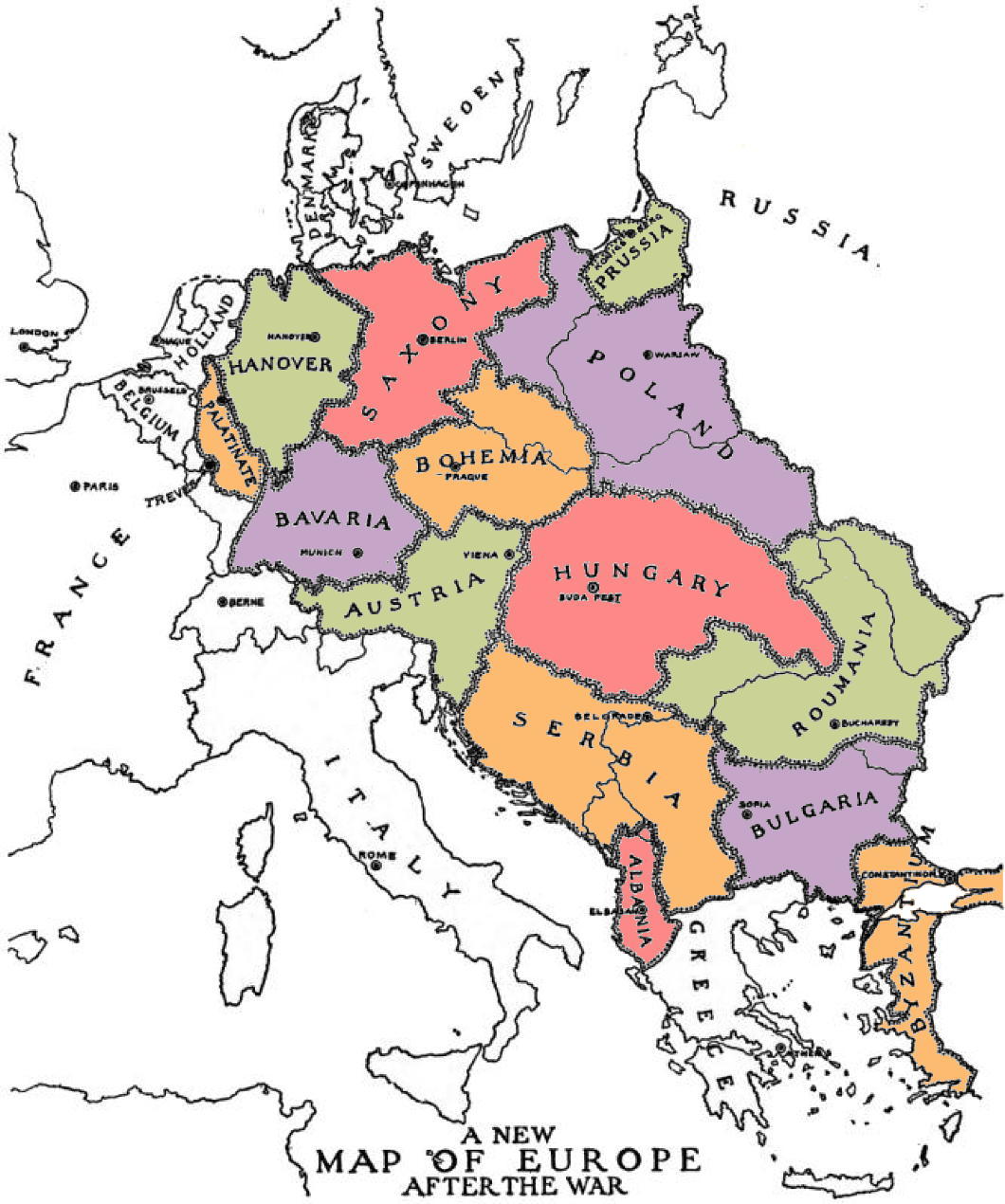
Ralph Adams Cram was not just one of the most influential American architects of the first half of the twentieth century: he was a rounded intellectual who expressed his thinking in fiction, essays, and books in addition to the buildings he designed.
Cram (and arguably even more his business partner Goodhue) had a gift for bringing the medieval to life in a way that was neither archaic nor anachronistic but instead conveyed the gothic (and other styles) as living, organic traditions into which it was perfectly legitimate for moderns to dwell, dabble, and imbibe.
His literary efforts include strange works of fiction admired by Lovecraft and political writings inviting America to become a monarchy. These have value, but it’s entirely justifiable that Cram is best known for his architectural contributions.
All the same, amidst the clamours of the First World War this architect of buildings played the architect of peoples and sketched out his idea of what Europe after the war — presuming the defeat of the Central Powers — would look like.
In A Plan for the Settlement of Middle Europe: Partition Without Annexation, Cram set out his model for the territorial redivision of central and eastern Europe “to anticipate an ending consonant with righteousness, and to consider what must be done… forever to prevent this sort of thing happening again”.
Cram, who provided a map as a general guide, predicted the return of Alsace-Lorraine to France, Schleswig-Holstein to Denmark, the Trentino and Trieste to Italy, much of Transylvania to Romania, Posen to a restored Poland, and Silesia divided in three.
Fundamental to the architect’s thinking was that “neither Germany, Austria-Hungary, nor Turkey can be permitted to exist as integral or even potential empires”. Austria and Hungary would be split and Germany needed to be partitioned (not, as some later plans had it, annexed). (more…)
What do Namibians know of Germany?
Namibia spent more than twice as long under South African administration then it did when it was German South West Africa, but its formative years under the Germans continue to have an influence.
For one thing, you can stumble around streets marked Zeppelinstraße and Bismarckstraße, not to mention the quite quaffable beer the country produces. Germany’s most remembered act in Namibia, alas, is the massacre of the Herero tribe, whose women are today known for their colourful pseudo-Victorian traditional dress.
Still, a third of the country’s white population are of German descent and German was an official language until 1990, though Namibian Black German (which linguists debate whether it is a dialect or a pidgin) is now nearly extinct. Most German Namibians today would speak Afrikaans on an everyday basis and have a strong grasp of English too.
But what does the average Namibian on the street know of Germany? In the above video a man goes about asking precisely that. Particularly interesting is that moneyed Frankfurt seems to be much better known than the political capital of Berlin. If only there was a video asking Germans what they know of Namibia…
Weimar’s Black, Red, and Gold
In fact, there was a great deal of overlap between these two sides, and in the most recent Junge Freiheit Dr Karlheinz Weißmann explains how the troubled Weimar Republic made its choice of national symbols.
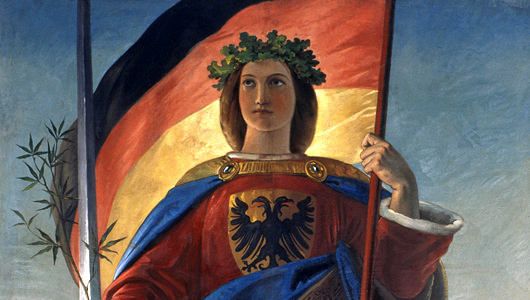
The colours of the Republic
by Karlheinz Weißmann — Junge Freiheit 18 February 2019
(slapdash unofficial totally unauthorised translation)
At the end of December 1918, Harry Graf Kessler noted confusedly in his diary that supporters of the [liberal republican] German Democratic Party (DDP) had marched through the centre of Berlin, with the “Greater German colours” black-red-gold and singing Der Wacht am Rhein.
In fact, the left-wing liberals were the only political group next to the Völkisch movement who had clung on to the black-red-gold. For both of them, it was about the ideal of an all-German state, including the Austrians. For the Liberals, it also represented the ideals of the revolution of 1848, while for the Völkisch there was the idea that black, red, and gold were the ancient Aryan colours.
During the period of downfall in 1918 it wasn’t the black-red-gold that mattered: it was the red of the socialists. Majority and Independent Social Democrats as well as the Communists all used it as a symbol. Red armbands, red cockades, and red flags marked the followers of the new republic, whose socialist underpinning was generally believed.
Black-red-gold as last option
By contrast, the old imperial colours of black-white-red almost disappeared. Significantly, the naval mutineers in Kiel had barely raised a hand to defend them. But the soldiers returning home from the front marched under black-white-red flags — which they had made themselves — and were received in the cities, even in Berlin, with black-white-red flags and decorations. The newly established Freikorps also deployed the old imperial colours, as did the cockade of the new Reichswehr whose ranks included many opposed to the republican order.
With this juxtaposition of revolutionary red and the black-white-red of tradition, black-red-gold — Schwarz-Rot-Gold — came as the last option. Some hoped that, on the one hand it would stand for moderation and against total upheaval, while on the other hand it suggested that defeat in the war did not spell the final downfall of the nation.
On 9 November 1918 an organ of the far right, the Alldeutschen Blätter, published an essay entitled “Black-Red-Gold”:
“The birth of Greater Germany is approaching! … Cheer the old black-red-golden colours! Decorate like Vienna your houses with the black-red-golden flags, bows, and bands and show all the world from Aachen and Königsberg to Bozen [Bolzano], Klagenfurt, and Laibach [Ljubljana] that we are a united people of brothers, in no distress of separation or peril.”
Symbol of treason
The 18 February 1919 decision of the State Committee of the Republic to adopt black-red-gold as provisional colours of the Reich was still supported by the expectation that a Greater German Republic would emerge. But the “Anschluss” of Austria was banned at the instigation of the victorious powers and in flagrant contradiction to the right of the self-determination of peoples. This resulted in the first serious discrediting of the black-red-gold.
The second was that black, red, and gold had been reputed to be a symbol of treason since the beginning of the war. A group of deserters and pacifists calling themselves the “Friends of the German Republic” — financed with French money and operating from Switzerland — used the colours for their cause as early as 1915, and as early as the spring of 1918 Entente aircraft distributed calls for desertion and revolution along the western front, marked with a black-red-gold stripe or border.
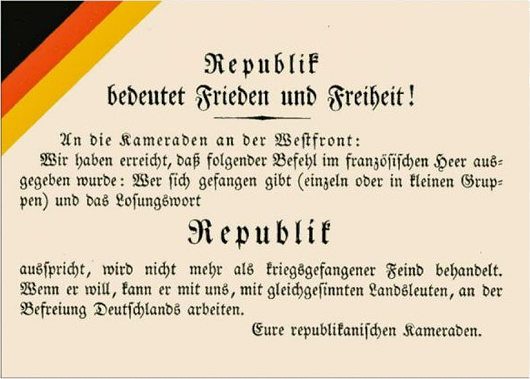
Almost certainly the majority of the population was relieved when, on instructions from the national government, the workers’ and soldiers’ councils adopted the black-red-gold [replacing the red of revolution] but passive acceptance was not enough to give the colour combination permanent support. This was particularly evident in the peculiar “flag compromise” presented by the government with the support of Majority Social Democrats, the Center Party, and part of the DDP during the deliberations of the National Assembly.
According to this compromise, the black-red-gold was introduced as the national flag, while the merchant ensign was the old black, white, and red — albeit with a small black-red-gold flag infelicitously shoved in the canton. Interior Minister Eduard David’s rationale for the choice — that the old colours had been “party” rather than “national” colours — simply did not correspond to fact.
Symbol of Greater Germany
Closer to the truth was the justification that black, red, and gold were the symbols of a Greater Germany. Interior Minister David said:
“What dynastic Germany could not do, democracy must succeed in doing: achieving moral conquests beyond the frontier and, above all, among those who by blood and language belong to us. To win the Greater German unity must now be our goal, not through war and violence, but through the recruiting power of the new republican Germany, and let us fly forward in front of the black-and-red-gold banner!”
In any case, Article 3 of the Weimar Constitution, which entered into force on 11 August 1919, was far from providing a sound answer to the flag question of the young state. As constiutional scholar Ernst-Rudolf Huber wrote:
“This Weimar flag compromise became the cause of endless strife. If the constitutional function of state colours exists in their symbolic power to integrate the state’s unity, the state-sanctioned dualism of contrasting colours manifested in the Weimar flag compromise is a permanent element of disintegration. The flag compromise, with its juxtaposition of the old and new colours, did not diminish the problem of the colour change but rather aggravate it.”
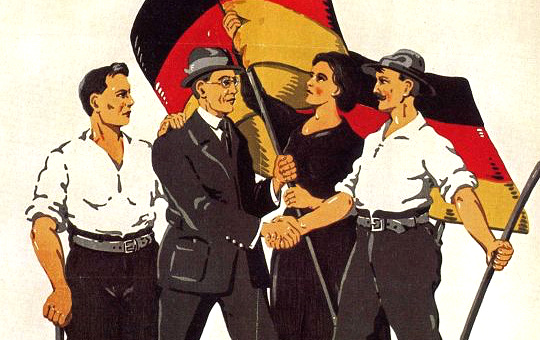
A Chapel in Bavaria
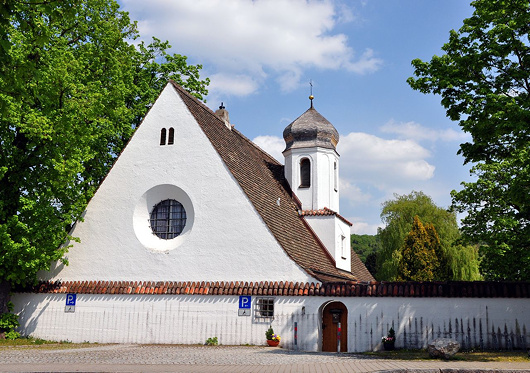
The Friedhofskapelle, or cemetery chapel, in Herrsching on the Ammersee in Upper Bavaria is a wonderful model of a small church or chapel.
It was designed in 1926 by Roderich Fick, who was a disciple of Theodor Fischer. Herr Fick participated in an expedition to traverse Greenland and joined the German colonial service in Cameroon, after the war moving to Herrsching in 1920.
During the Third Reich he was tasked with redesigning the city of Linz where Hitler had spent his childhood, but the dictator found Fick’s plans somewhat restrained, while Martin Bormann was constantly picking fights with the architect. The dominant style of the regime did not align with Fick’s preference for humble, unpretentious tradition in building design.
After the war he was sentenced to aid in the reconstruction of Munich, and also helped restore the magnificent Town Hall of Augsburg.
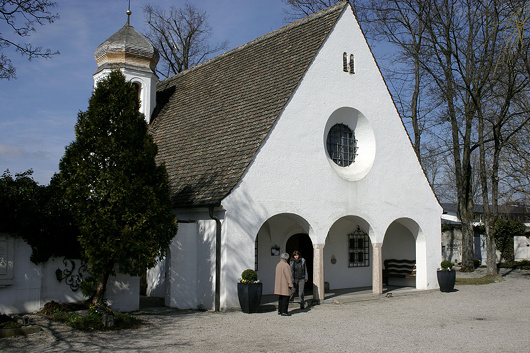
“Get me ze Führer!”
Stereotypes of Nazi generals in British war films
“The reason for my uniform being a slightly different colour to yours
is never explained.”
The British are, of course, obsessed with the Nazis. There are many reasons for this, amongst which we must include the large number of really quite good war films produced during the 1950s and 1960s.
For some indiscernible reason these movies have the virtue of being eternally rewatchable and many a cloudy Saturday afternoon has been occupied by Sink the Bismarck!, Where Eagles Dare, or The Colditz Story.
The genre also deploys with a remarkable regularity a number of familiar tropes of ze Germans which the above clip from a British comedy sketch programme (introduced to me by the indomitable Jack Smith) aptly mocks.
The angel of Görlitz
An anonymous benefactor gives Görlitz half a million euros every year for the benefit of the Old Town.
24.02.2015, by MONA JAEGER, GÖRLITZ (Frankfurter Allgemeine Zeitung)
PASTOR, YOU MUST know, are there angels? He jumped up, went to a shelf, grabbed a thin brochure, and opened it. Here, says Minister Hans-Wilhelm Pietz, pointing to a photograph of the Church of the Holy Trinity, the roof was leaking, it was almost raining. And there, at the Lutherkirche, the facade was washed-out.
Four houses of God are maintained by the Lutheran church in Görlitz, between 100 and 700 years old. From the crypt to the tower there is always something to bang, grind, or sand. Sometimes this costs 500 euro, sometimes 5,000. In any case more than the 2,500 congregants contribute to the Sunday collection. “Alone, we would be overwhelmed with the neverending renovations.” But there is indeed him. Or her. An angel, at least, Father Pietz is certain.
He must be a pretty fat angel. He distributes half a million euros in the city every year — €511,500 to be exact. Not an angel as such, but a wealthy entrepreneur or someone with a rich inheritance, the Görlitzers speculate at the bakery counter or at their Stammtisch. Who else would have had so much money left for twenty years that he could simply donate to the city?
For it’s been the same game in Görlitz every year for that long: always in the first quarter, without announcement, half a million euros (formerly a million marks) find their way into the municipal coffers. It has always been a different date. This year it was 18 February. Whether the money will come next year, the donor does not reveal. (more…)
Hamburger Abendblatt
The German advertising agency Oliver Voss created this series of ads for the Hamburger Abendblatt, Hamburg’s daily evening newspaper.
Oliver Voss have done web and print ads for the Abendblatt before but the illustrations in this series of posters strike a jovial pose, feeling perfectly contemporary while still informed by a sense of the 1950s.
The summery beach scene is my favourite.
A Handsome Hamsun
Book design is a craft sadly neglected in the English-speaking world. In paperbacks, the French reign supreme, while the Teutons and Scandos design the most elegant hardcover books.
This German edition of Ingar Sletten Kolloen’s biography of Knut Hamsun was designed by Frank Ortmann for Landt Verlag, founded by the conservative popular historian Andreas Krause Landt (aka Andreas Lombard). Landt Verlag is now an imprint of Thomas Hoof’s Manuscriptum publishing firm. Hoof is better known for starting Manufactum, the retail company known for offering high-quality goods made through traditional methods.
I’ve never read any Hamsun myself though he has been strongly recommended by friends with reliable tastes. This Norwegian writer is widely read amongst the Germans but not so amongst the Anglos, and perhaps not surprisingly since he was an uncompromising Anglophobe and had praise for all things German.
Anglophobia was not his worse offence – a Nobel laureate, he ended up giving away the actual medal as a gift to Goebbels – but no less an unquestionable anti-Nazi than Thomas Mann hoped that “the stigma of his politics will one day be separated from his writing, which I regard very highly”.
The designer Frank Ortmann impressed the name of the publisher by incorporating letter-L initials into the rather Hellenic ornamental frame of the book. He’s also managed to banish the dreaded and ubiquitous barcode to a little banderole which also includes a short introductory text, preserving the visual integrity of the book itself.
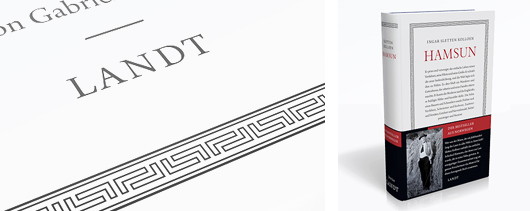
Speyer
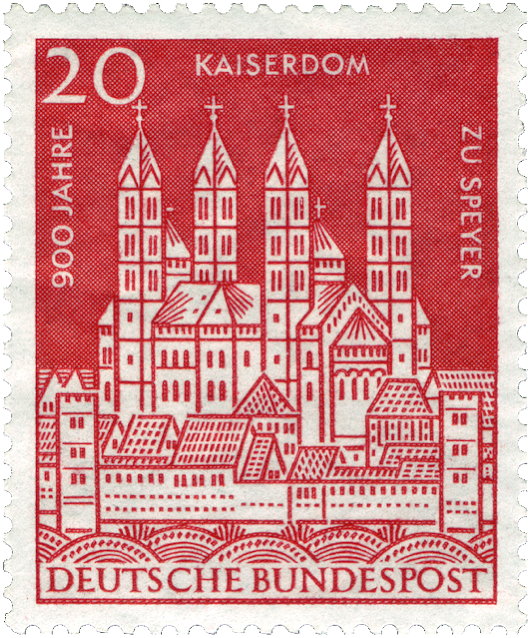
This 1961 postage stamp celebrates the consecration, nine centuries earlier, of the Imperial Cathedral Basilica of the Blessed Virgin of the Assumption and Saint Stephen at Speyer — today the largest Romanesque church still standing.
Germania
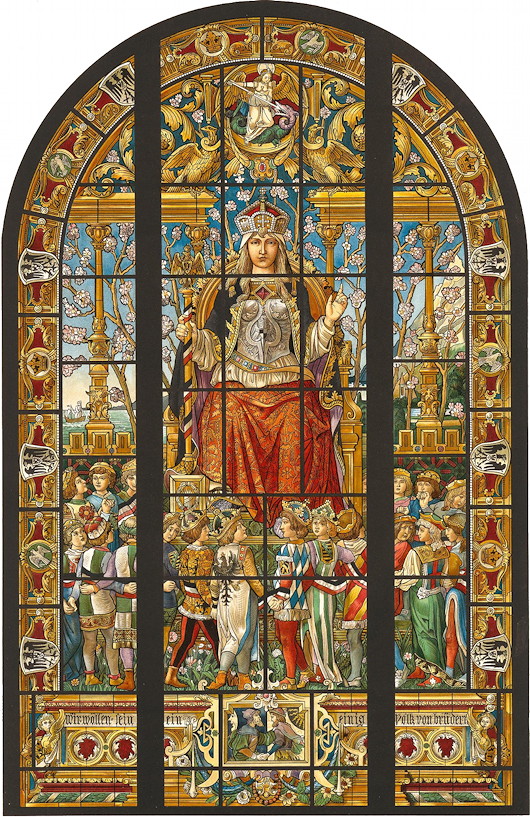
I’ve been reading Golo Mann’s History of Germany Since 1789 — cracking stuff.
This depiction of Germania, the personification of the German nation, was for a stained-glass window in the Reichstag building, built between 1884 and 1894 in Berlin and since 1999 home once again to the German parliament.
Haus Altmark
While the remarkable rebuilding and rehabilitation of Dresden is of a much more recent vintage, the historicist design of Haus Altmark (Herbert Schneider, 1953-1956) in that city is another good example of the Socialist Classicism of the DDR.
(c.f. Leipzig Opera House)
Leipzig Opera House
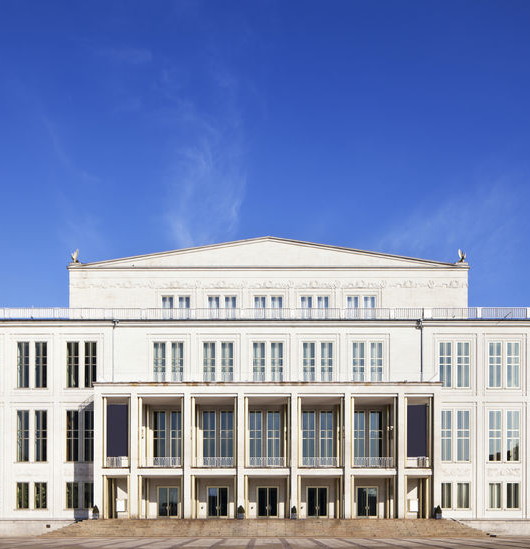
The Leipzig Opera House is the swansong of Socialist Classicism as an architectural style. The 1954 plans of the architect Kunz Nierade had to be toned down mid-construction, with some of the sculptural adornment simplified, as the official aesthetics of the German Democratic Republic shifted towards a more aggressive modernism.
While the Soviet Union provided the more well-known examples of Socialist Classicism, the Germans rather typically (but sparsely) excelled their Russian overlords. Admittedly, the quality was inconsistent: the Karl-Marx-Allee has some fine details but the overall plan leaves me cold, though postmodernists Philip Johnson and Aldo Rossi have praised it.
I enjoy the restrained classicism of this building, though the flatness of the façade leans a little towards the dull, with only the projecting portico providing a bit of comforting depth. Critics have pointed out the lack of light-and-shadow contrast during the daytime, and have tended to prefer the building’s nighttime appearance. It’s worth mentioning that the snowflake-like hanging lamps in the building’s foyer have a significant place in the design history of East German lighting fixtures (a subject about which I know now more than I ever expected).
The finality of Socialist Classicism’s end cannot more clearly be emphasised when comparing the Leipzig Opera House with the assaulting brutality of the Neues Gewandhaus concert hall (1977) across the Augustusplatz in a style we associate more closely with the DDR period. That the similarly styled Palast der Republik in Berlin — possibly the building most readily associated with East Germany’s socialist regime — has been completely demolished to be replaced by a reconstruction of the old city palace is a reminder of the hopeful possibilities we have at hand.

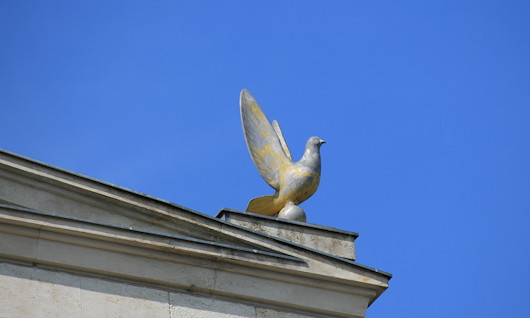
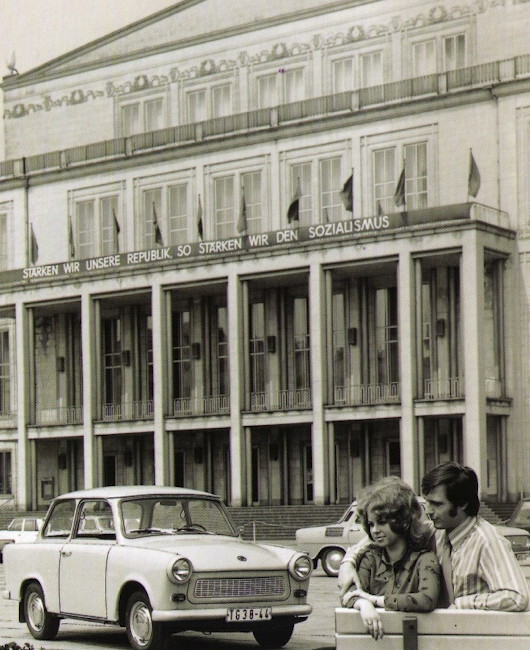
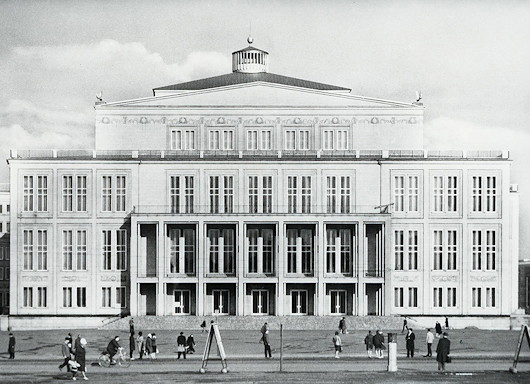
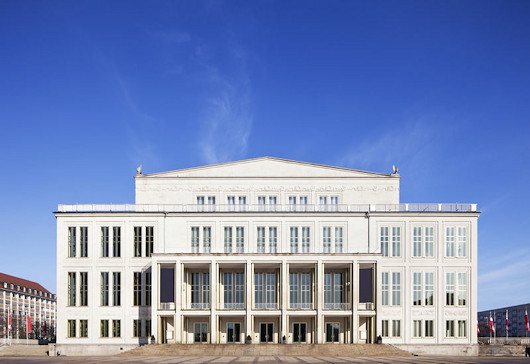
Search
Instagram: @andcusack
Click here for my Instagram photos.Most Recent Posts
- Waarburg October 2, 2024
- A Prize for the General September 23, 2024
- Articles of Note: 17 September 2024 September 17, 2024
- Equality September 16, 2024
- Rough Notes of Kinderhook September 13, 2024
Most Recent Comments
Book Wishlist
Monthly Archives
Categories

